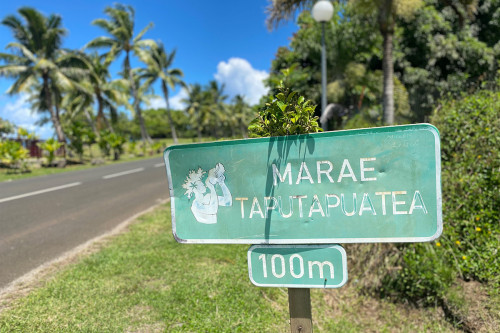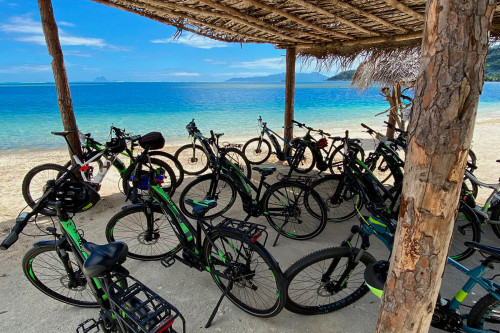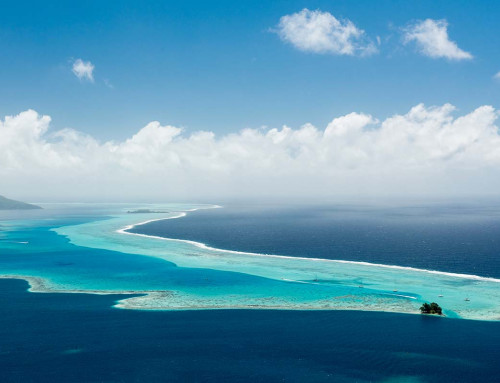Raiatea is the Cradle of Polynesian civilization. in the heart of the famous Polynesian triangle that links Hawaii, Easter Island and present-day New Zealand. Numerous archaeological remains bear witness to this glorious era: the Marae, places of civil and religious power. The Taputapuatea marae in Raiatea was the largest of them all, and also the most emblematic. A visit is a must for all travelers wishing to better understand the Pacific Islands.
What Is a Marae?
In pre-colonial times, marae were the basic structures of Polynesian society. They can be found throughout the wider Polynesia, from the Tonga Islands to New Zealand. Depending on their size and location, they could symbolize religious and political powers, and to a lesser extent the organization of the family clan. The marae were above all sacred lands, sometimes sacralized to the point of becoming taboo. They were also the place for celebrations of all kinds: festive, warlike and cultic.

In French Polynesia, particularly in Raiatea, the marae take the form of a rectangular platform, made of volcanic stones or pieces of coral. Generally, some large standing stones flank this empty surface by at one end. Don’t expect to see anything built, as the structure is now open air. Although these buildings have always given rhythm to religious life, the representation of divine figures on the spot is very discreet or even absent.
The marae are sober, almost austere ensembles, where the essential thing is not to see but to feel. The ancients nurtured this culture of secrecy: the marae were built away from the areas of settlement to better mark the importance of the links uniting their community to the land.
Taputapuatea Marae in Raiatea: The Origins of the Polynesian Nation
The marae had various functions and an aura generally limited to the family, the village, the island, but rarely beyond. Only the Taputapuatea marae on Raiatea had an almost international, at least pan-Polynesian, dimension.
Influence of the Marae on Raiatea
From a historical point of view, the Taputapuatea marae is a thousand-year-old structure. Originally dedicated to the god of creation, it quickly gave itself over to the cult of the god Oro, that of fertility and then of war. The veneration of Oro then spread to the current islands of the Society and even further afield. This extension made the Taputapuatea marae the religious and cultural epicenter of a vast geographical area. Indeed, each newly founded marae was made up in part of sacred stones from the original marae. The link was both organic and spiritual.

In fact, the Taputapuatea marae became international. In Raiatea, the priests of all the marae from this extension gathered. Military alliances were concluded there, kings were crowned and navigators exchanged their knowledge. Beyond the religious cult, the Taputapuatea marae became the expression of a common cultural identity: the birth of a Polynesian nation.
Historic Site of Inestimable Value
From this epic, we find marae called Taputapuatea in Moorea, Tahiti, the Marquesas Islands, Hawaii, and many other islands. As a result of internal wars and European colonization, the Taputapuatea marae has lost its appeal and the symbolism that surrounded it. Little or not maintained, it benefited from renovation and restoration work in the 1990s. With the support of the French authorities, the site was classified as a Unesco World Heritage Site in 2017. The local cultural association Na Papa E Va’u Raiatea has largely contributed to the development of the site.
At the Taputapuatea marae, more than a thousand years of Polynesian history are inscribed in the stone and coral. Its influence on the settlement of the Pacific Islands and the development of the Maohi culture is considerable. This original land therefore raises questions of heritage and transmission. Moreover, the restored vestiges are authentic. Now protected and benefiting from an exceptional natural setting, a visit to the site is a must.
How to Visit the Marae in Raiatea?

The Taputapuatea marae is located on the eastern slope of the southern part of the island. It is quite isolated and away from the residential areas. All you need is a rental car in Raiatea or a bicycle. The most practical solution is to stay in one of the hotels in Raiatea located just a few hundred meters away, notably the Hotel Atiapiti.
Despite its Unesco recognition, the site has no visitor center or documentation center. Consequently, there is no contact person on site and only a few information panels provide visitors with information. The experience remains pleasant and enjoyable. Note also that a marked path leads to a fantastic viewpoint overlooking the site.
Our advice: take a local guide with you. The history of the Taputapuatea marae in Raiatea is mainly oral. It mixes ancient beliefs with family stories. We therefore invite you to book a guided tour today with a visit to the site:
Discover the Island of Raiatea
From canoeing up a river to learning street art in Uturoa, there is no shortage of activities in Raiatea. Your trip to French Polynesia is just beginning. Contact us now to plan your next itinerary in the South Pacific Islands.









Leave A Comment